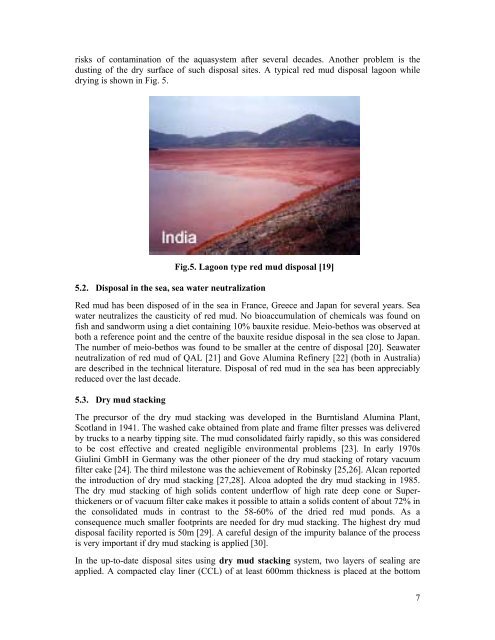De-watering, disposal and utilization of red mud: state ... - Redmud.org
De-watering, disposal and utilization of red mud: state ... - Redmud.org
De-watering, disposal and utilization of red mud: state ... - Redmud.org
Create successful ePaper yourself
Turn your PDF publications into a flip-book with our unique Google optimized e-Paper software.
isks <strong>of</strong> contamination <strong>of</strong> the aquasystem after several decades. Another problem is the<br />
dusting <strong>of</strong> the dry surface <strong>of</strong> such <strong>disposal</strong> sites. A typical <strong>red</strong> <strong>mud</strong> <strong>disposal</strong> lagoon while<br />
drying is shown in Fig. 5.<br />
Fig.5. Lagoon type <strong>red</strong> <strong>mud</strong> <strong>disposal</strong> [19]<br />
5.2. Disposal in the sea, sea water neutralization<br />
Red <strong>mud</strong> has been disposed <strong>of</strong> in the sea in France, Greece <strong>and</strong> Japan for several years. Sea<br />
water neutralizes the causticity <strong>of</strong> <strong>red</strong> <strong>mud</strong>. No bioaccumulation <strong>of</strong> chemicals was found on<br />
fish <strong>and</strong> s<strong>and</strong>worm using a diet containing 10% bauxite residue. Meio-bethos was observed at<br />
both a reference point <strong>and</strong> the centre <strong>of</strong> the bauxite residue <strong>disposal</strong> in the sea close to Japan.<br />
The number <strong>of</strong> meio-bethos was found to be smaller at the centre <strong>of</strong> <strong>disposal</strong> [20]. Seawater<br />
neutralization <strong>of</strong> <strong>red</strong> <strong>mud</strong> <strong>of</strong> QAL [21] <strong>and</strong> Gove Alumina Refinery [22] (both in Australia)<br />
are described in the technical literature. Disposal <strong>of</strong> <strong>red</strong> <strong>mud</strong> in the sea has been appreciably<br />
<strong>red</strong>uced over the last decade.<br />
5.3. Dry <strong>mud</strong> stacking<br />
The precursor <strong>of</strong> the dry <strong>mud</strong> stacking was developed in the Burntisl<strong>and</strong> Alumina Plant,<br />
Scotl<strong>and</strong> in 1941. The washed cake obtained from plate <strong>and</strong> frame filter presses was delive<strong>red</strong><br />
by trucks to a nearby tipping site. The <strong>mud</strong> consolidated fairly rapidly, so this was conside<strong>red</strong><br />
to be cost effective <strong>and</strong> created negligible environmental problems [23]. In early 1970s<br />
Giulini GmbH in Germany was the other pioneer <strong>of</strong> the dry <strong>mud</strong> stacking <strong>of</strong> rotary vacuum<br />
filter cake [24]. The third milestone was the achievement <strong>of</strong> Robinsky [25,26]. Alcan reported<br />
the introduction <strong>of</strong> dry <strong>mud</strong> stacking [27,28]. Alcoa adopted the dry <strong>mud</strong> stacking in 1985.<br />
The dry <strong>mud</strong> stacking <strong>of</strong> high solids content underflow <strong>of</strong> high rate deep cone or Superthickeners<br />
or <strong>of</strong> vacuum filter cake makes it possible to attain a solids content <strong>of</strong> about 72% in<br />
the consolidated <strong>mud</strong>s in contrast to the 58-60% <strong>of</strong> the dried <strong>red</strong> <strong>mud</strong> ponds. As a<br />
consequence much smaller footprints are needed for dry <strong>mud</strong> stacking. The highest dry <strong>mud</strong><br />
<strong>disposal</strong> facility reported is 50m [29]. A careful design <strong>of</strong> the impurity balance <strong>of</strong> the process<br />
is very important if dry <strong>mud</strong> stacking is applied [30].<br />
In the up-to-date <strong>disposal</strong> sites using dry <strong>mud</strong> stacking system, two layers <strong>of</strong> sealing are<br />
applied. A compacted clay liner (CCL) <strong>of</strong> at least 600mm thickness is placed at the bottom<br />
7


